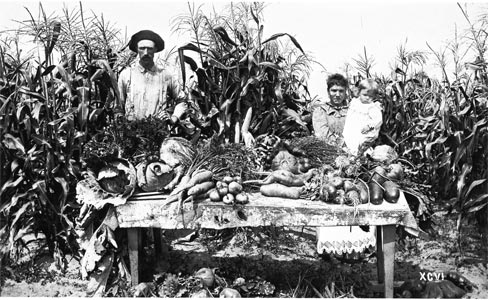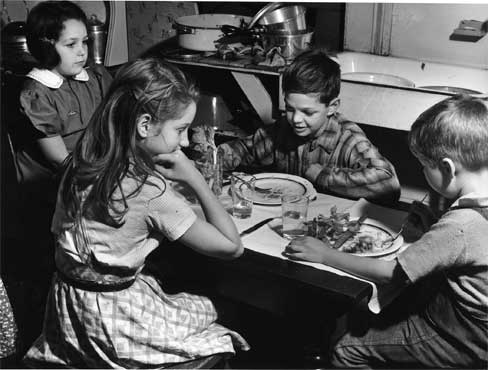Exhibit Review
Key Ingredients: America By Food
Sponsors: Smithsonian Institution Traveling Exhibition Service (SITES) and the Federation of State Humanities Councils; Exhibit design and fabrication: SurroundArt; Curator: Charles Camp
Traveling exhibit
If media portrayals are any indication, food weighs heavily on the minds of Americans. While much of that attention relates to the negative realities of health issues, dieting, and eating disorders, a traveling exhibit now making its way across the country takes a look at the sunnier side of America's evolving relationship with food.
Key Ingredients: America By Food is a product of the Museum on Main Street program, which is sponsored jointly by the Smithsonian Institution Traveling Exhibition Service (SITES) and state humanities organizations. Spanning America's history from native hunting and gathering to modern fast food, the exhibit delves into the multifaceted connection between the country's foodways and its culturally diverse heritage. Complementing the exhibit is an interactive website, http://www.keyingredients.org, that invites people to share family recipes and food stories, learn about other food traditions, and post information on favorite restaurants off the beaten path.
The exhibit includes a series of panels containing five themed sections including "Land of Plenty," "Local Flavors," "Dynamic Delivery," "Festival of Feasts," and "Home Cooking." Together, these topics demonstrate how traditions originating from a survival mechanism can grow into traditions that reveal unique details about cultures throughout the world, especially when those cultures are concentrated into one land and one people.
The first section, "Land of Plenty," examines the ways Americans find their food. Beginning appropriately with the Native American experience, traditions of hunting, gathering, and early farming are detailed. This section also describes the societal structures that evolved to enhance food supply, including plantations and ranches. In its examination of regional immigration and influences, the "Local Flavors" narrative deftly sums up much of the exhibit's intent: "Food is the bounty of the earth and the work of human hands. It has unrivaled power to connect people with place, to create an identity for a community or region and to plant an enduring memory in people passing through."
"Dynamic Delivery" and "Festival of Feasts" address topics that range from cultural minutiae to mass marketing. A taut timeline of industrial progress takes shape while still weaving in emotional themes of family and community. Canning technology is credited as a major breakthrough because of its usefulness for families and the food industry alike. The exhibit links the experience of family and industrial canning through the examples of entrepreneurs like Joseph Campbell, whose cherub-cheeked "Campbell's Kids" signified health and comfort to many Americans.
Advances did not occur just in factories. New gadgets have been commonplace in kitchens throughout history. Even today, one may find hundreds of kitchen items at any discount store, not to mention the kitchen wonders advertised "as seen on TV." Supporting the exhibit at its showing in Natchitoches, Louisiana, were some 30 real life gadgets.(1) Cane River Creole National Historical Park provided artifacts such as crockery, a bench-mounted coffee grinder, a swing churn, and ice tongs that all represented technological advances of their time. While the nature of a traveling exhibit limits opportunities for moving parts, the adaptation of some of the more modern gadgets would improve the interactive experience. The only real interactive element in the exhibit is a series of "lids" that can be lifted to reveal bits of interpretation on common American foods.
Although the progress of mechanization and agricultural improvements figures prominently, the overarching narrative returns time and again to foodways of the family. The exhibit's "Home Cooking" narrative establishes the link between food and memory. Replicas of handwritten recipes set the tone for stories about the making of traditional dishes, their conveyance to succeeding generations, and how the traditions served to define the family line. The New World's mythic meal, the first Thanksgiving, is described as the first merger of cultures that set the precedent for America's food traditions throughout its history. Likewise, Christmas is portrayed as a season of relative plenty and special foods, transcending socio-economic lines and equalizing all Americans.
The exhibit maintains its celebratory sentiment using heavily idealized imagery to make the visual connection between food and family. A 1950s illustration of a housewife advertising the convenience of her Hotpoint electric range is featured prominently in the exhibit and accompanying promotional materials. But until such modern conveniences became widespread, getting and preparing food was a difficult task for many Americans. Most people labored in dangerous circumstances for their food, either in growing, gathering, or preparation. Key Ingredients touches upon the challenges of the family farm and the role slaves played in farming, but with little detail. For example, planters are described as recognizing that certain peoples of other countries were skilled in the cultivation of specialized crops and "quickly appropriated" their expertise in America.
Receiving even less attention are many events that led to the advancements in food storage and preparation that feature prominently in the exhibit. The advents of a skyrocketing American population and ever-busier lifestyles are explained as the primary drivers of these advances. However, many of these improvements were heavily influenced by events related to food safety, including watershed scandals in the food industry and the establishment of the United States Food and Drug Administration. Events such as these played highly significant roles in shaping our own food traditions today. Prevalent regional folklore and traditions on the safety of food and "making do" in lean periods would provide additional depth to the exhibit's already strong emphasis on cultural diversity.
Like so many traditions, the food-family connection in America is rapidly changing. Cultural resource management professionals and other visitors to Key Ingredients will gain a new appreciation for the role food has played historically in America's development. In fact, the exhibit succeeds so well in its quest to document the ways food traditionally connects families and cultures that modern realities of fast food and single-parent households will leave some visitors with an aftertaste of bittersweet nostalgia.
Jeff Guin
National Center for Preservation Technology and Training
National Park Service
Note
1. The exhibit, co-sponsored by the Smithsonian and the Louisiana Endowment for the Humanities, was on display at the Old Courthouse Museum in Natchitoches, Louisiana, from August 15 to October 19, 2006. A full list of exhibit venues and dates is available online at http://www.keyingredients.org/000_venues/000_venues_01.asp.


